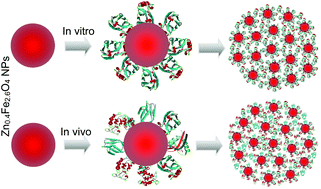Adsorption of proteins on oral Zn2+ doped iron oxide nanoparticles in mouse stomach and in vitro: triggering nanoparticle aggregation
Abstract
Oral route is one of the most important portals of nanoparticle entry to the body. However, in vivo protein corona formed in the gastrointestinal tract has not been studied owing to the difficulty for the recovery of nanoparticles from the in vivo environment. In this study, by using the magnetic property of iron oxide nanoparticles (Fe3O4 NPs) and Zn2+ doped iron oxide nanoparticles (Zn0.4Fe2.6O4 NPs), the nanoparticles were separated from the gastric fluid after oral administration in mice. The effects of Zn2+ doping and static magnetic field (SMF) treatment on the protein adsorption on the nanoparticles were investigated in vitro and in vivo. Zn2+ doping decreases the adsorption of pepsin on the nanoparticles in vitro and affects the composition of the protein corona in vivo and enhances protein adsorption-induced aggregation of the nanoparticles in vitro and in vivo. SMF treatment affects the composition of the protein corona of Fe3O4 NPs and Zn0.4Fe2.6O4 NPs, and enhances the aggregation of Fe3O4 NPs and Zn0.4Fe2.6O4 NPs in vivo. Furthermore, the results demonstrate that electrostatic attraction is the crucial force to drive adsorption of proteins on Fe3O4 NPs and Zn0.4Fe2.6O4 NPs and protein adsorption-induced change in the surface charge of nanoparticles plays an important role in the pH-dependent aggregation of the nanoparticles. In addition, the work provides the evidence that the protein adsorption-induced aggregation of Fe3O4 NPs and Zn0.4Fe2.6O4 NPs has no effect on their magnetic susceptibility. The results highlight that Zn0.4Fe2.6O4 NPs may be used as a potential oral magnetic resonance imaging contrast agent in diagnosis of gastrointestinal disease.



 Please wait while we load your content...
Please wait while we load your content...